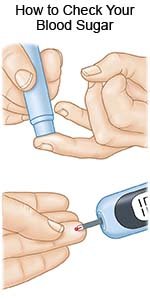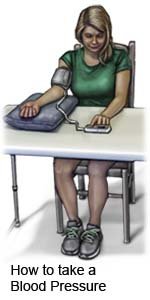Diabetic retinopathy (DR) is eye damage caused by long-term high blood sugar levels. The walls of the blood vessels in the retina weaken and leak blood. This causes swelling and vision problems. Over time, new, weak blood vessels grow, leak blood, and cover the center of the retina. DR can lead to blindness.
What increases my risk for DR?
- Having diabetes for more than 5 years
- Poor blood sugar control
- High blood pressure, high cholesterol, pregnancy, or kidney disease
- Smoking
- Eye surgery or other eye problems
- Family members with DR

What are the signs and symptoms of DR?
- Blurred vision
- Seeing red or black wavy lines that look like a curtain or spider web
- Seeing light flashes or red, black, or grey floating spots (floaters)
- Vision loss
How is DR diagnosed?
Your healthcare provider will examine your eyes. Screening may be done regularly. Screening means you are checked for DR before you have signs or symptoms. You will be checked within 5 years of a type 1 diabetes diagnosis, because DR can take 5 years to develop. Your provider will tell you when to get checked. You will need to be checked immediately after a diagnosis of type 2 diabetes. If screening shows you do not have DR, your provider will tell you how often to get screening in the future. The following may be used to check for DR:
- Dilated indirect ophthalmoscopy may show early damage in your retina. A magnifying lens is used to see your retina and other parts of your eye. Eye drops are placed into your eyes to make your pupils larger.
- Fluorescein angiography uses a dye to show blood leakage and damage in your eye.
- Fundus photography may show your DR and how severe it is.
How is DR treated?
You may not need treatment if you have mild DR. Healthcare providers will check your eyes regularly to monitor the damage to your retinas. Treatment may include any of the following:
- Laser treatment may slow DR and prevent blindness. This treatment shrinks the new blood vessels and seals the areas that have leaks.
- Anti-vascular endothelial growth factor (anti-VEGF) treatment helps reduce swelling and improves vision. During this treatment, medicine is injected into the vitreous of the eye. The vitreous is the gel-like material that fills the inside of the eye.
- Vitrectomy is surgery for severe DR. A vitrectomy may be needed if there is bleeding in the vitreous that does not clear.
- Medicines may be used to control your blood pressure and prevent kidney disease. Medicines may also help lower your cholesterol or triglyceride (fatty acid) levels.
What can I do to prevent or control DR?
- Control your blood sugar. Keep your blood sugar levels as close to normal as possible. You may need to check your blood sugar levels 3 times each day.
- Get your eyes checked at least 1 time each year. Your eye doctor may want to see you every 6 months or more often. If you are pregnant, get your eyes checked during the first 13 weeks of your pregnancy. You will need eye exams more often during pregnancy and for 1 year after you give birth.
- Check your blood pressure as directed. High blood pressure can damage the blood vessels in your eyes. This can lead to retinopathy. A normal blood pressure is 119/79 or lower. Talk to your healthcare provider about your blood pressure goals. Together you can create a plan to lower your blood pressure if needed and keep it in a healthy range. The plan may include lifestyle changes or medicines to lower your blood pressure.

- Talk to your healthcare provider about your cholesterol level. Lab tests are used to measure the amount of cholesterol in your blood. Your provider can help you create a plan to lower your cholesterol level if needed. You may need to make lifestyle changes or take medicines to control your cholesterol level.
- Plan for pregnancy if you are female. Pregnancy increases the risk for DR. Pregnancy can worsen existing DR and lead to serious vision problems. You can lower the risk by making sure your blood sugar is controlled before you get pregnant. Your provider may recommend you reach an A1c level of 6.5% or lower before pregnancy. Talk to your healthcare provider about ways to prevent or control DR during pregnancy.
- Exercise regularly. Ask your healthcare provider about the best exercise plan for you. He or she will tell you how to control your blood sugar when you exercise. You may need to check your blood sugar more often during exercise. Bring a snack with you when you exercise in case your blood sugar gets too low. If you have proliferative or severe DR, you may not be able to exercise hard or do resistance training. These activities increase the risk for retinal detachment (pulling away) or other vision problems. An eye specialist may need to help you with your exercise plan.

- Do not smoke. Nicotine can damage blood vessels in your eyes and make it more difficult to manage your diabetes. Do not use e-cigarettes or smokeless tobacco in place of cigarettes or to help you quit. They still contain nicotine. Ask your healthcare provider for information if you currently smoke and need help quitting.
Call your local emergency number (911 in the US) or have someone call if:
- You suddenly cannot see.
When should I call my doctor?
- Your blurred vision gets worse, or you start to see double.
- You see more floating spots.
- You see dark spots.
- You have questions or concerns about your condition or care.
